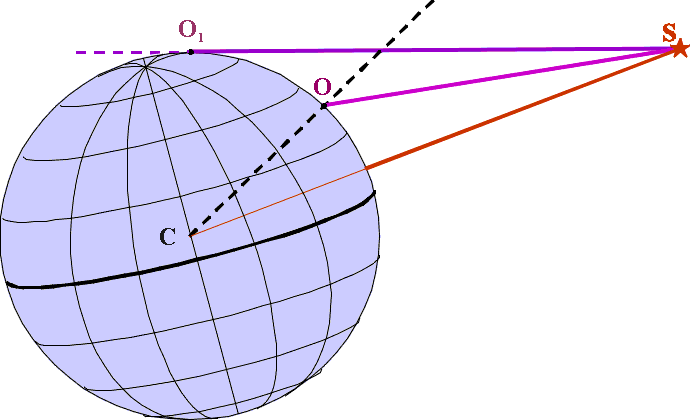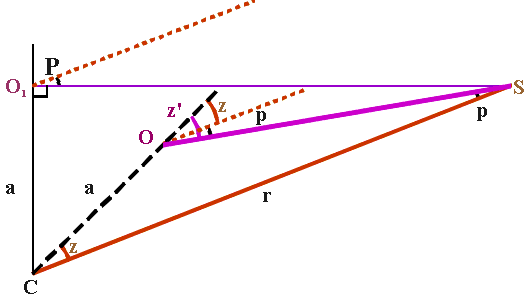-
"الفلك الموضعي"
- مقدمة
- الكرة الأرضية
- هندسة المثلثات الكروية
- ملاحظات حول الهندسة الكروية
- إحداثيات أفقية "alt-az"
- إحداثيات استوائية "HA-dec"
- إحداثيات استوائية "RA-dec"
- الزمن النجمي
- الانتقال بين أفقي و استوائي
- إحداثيات مجرية
- إحداثيات بروجية
- الانتقال بين بروجي و استوائي
- حركة الشمس و ضبط الوقت
- القمر
- الإنكسار الجوي
- شروق و غروب الشمس، الشفق
- اختلاف المنظر المركزي اليومي
- اختلاف المنظر الموسمي
- الزيغ
- المبادرة و الترنح :اضطراب محور الأرض
- تقاويم
- الامتحان الأخير
- الإحداثيات الفلكية، خضر الأحمد
- الحركة الظاهرية للنجوم (تفاعلي)
- الأقطاب السماوية (تفاعلي)

اختلاف المنظر المركزي اليومي
Refraction affects the apparent altitude of a star. But there are other phenomena that affect its apparent position, too. One of these is parallax. Refraction decreases the zenith angle, but parallax increases it.
Our observations are made from the surface of the Earth, not its centre.
This is irrelevant when observing distant objects such as stars. But for closer objects (e.g. within
the Solar System), a correction must be made. This is geocentric
parallax, or diurnal (daily) parallax
(since it varies
daily as the Earth spins around its axis).

To an observer at O, the zenith angle of object S appears to be z'.
Its true zenith angle, as seen from the centre
of the Earth C, is z, which is smaller.
Parallax is greatest for
an observer at O1,
where the object appears to be on
the horizon.
We define the angle of parallax p by p = z'-z.

If a is the Earth's radius, and r is the geocentric distance to the object,
then the plane
triangle OCS gives: sin(p) / a =
sin(180°-z') / r = sin(z') / r
that is,
sin(p)
= (a / r) sin(z')
Parallax is greatest at O1, where
z'=90°.
The parallax here is called the horizontal
parallax,
designated by
P = 90°-z, where
sin(P) = a
/ r.
For small angles, we may take P = a / r,
where
P is measured in radians.
In the general case, we may replace the term (a/r) by
sin(P), and write
sin(p) = sin(P)
sin(z')
or, since angles of parallax are generally small,
p
= P sin(z')
تمرين:
A minor planet (asteroid)
passes very near the Earth,
at a distance of 200,000 km.
What
will be its horizontal parallax?
(Take the Earth to be a sphere
of radius 6378 km.)
At St.Andrews (latitude
+56°20'),
the minor planet is observed to cross the meridian
at an apparent altitude of +35°.
What does its
declination appear to be?
What is its true declination, after correcting for geocentric parallax?
الحل:
What is its true declination, after correcting for geocentric parallax?
Apart from occasional near-earth asteroids,
the
Moon is the nearest natural object,
with average P around 57
arc-minutes.
So for calculating times of moonrise and moonset,
we must use an altitude of
0° - 16' [semi-diameter] - 34'
[refraction] + 57' [horizontal parallax]
=
+7'.
تمرين:
The Moon is at declination
-14°.
What will be its hour angle at moonrise
(when the top edge of the Moon first appears over the horizon),
at a
latitude of +56°20'?
الحل:
Allowing for lunar parallax is essential when predicting occultations of stars by the Moon (and, of course, solar eclipses).
تمرين:
Aldebaran is at Right Ascension
4h36m, declination +16°31'.
At a particular instant, the
geocentric coordinates of the Moon
are also Right Ascension
4h36m, declination +16°31'.
Local Sidereal Time at St.Andrews
(latitude +56°20') is 4h36m.
What will be the apparent
declination of the Moon, after correction for parallax?
(Take the
horizontal parallax of the Moon as 57 arc-minutes.)
The semi-diameter of the Moon’s
disc is 16 arc-minutes.
Will observers at St.Andrews see the Moon
occult Aldebaran?
الحل:
The
semi-diameter of the Moon’s disc is 16 arc-minutes.
Will
observers at St.Andrews see the Moon occult Aldebaran?
The Earth is not actually spherical. For more accurate calculations, we use the geoid:
a spheroidal solid which closely approximates the Earth's true shape. For any particular latitude, this gives corrected values for geocentric
distance a and geocentric latitude.
- شروق و غروب الشمس
ترجمة قتيبة أقرع
- اختلاف المنظر الموسمي